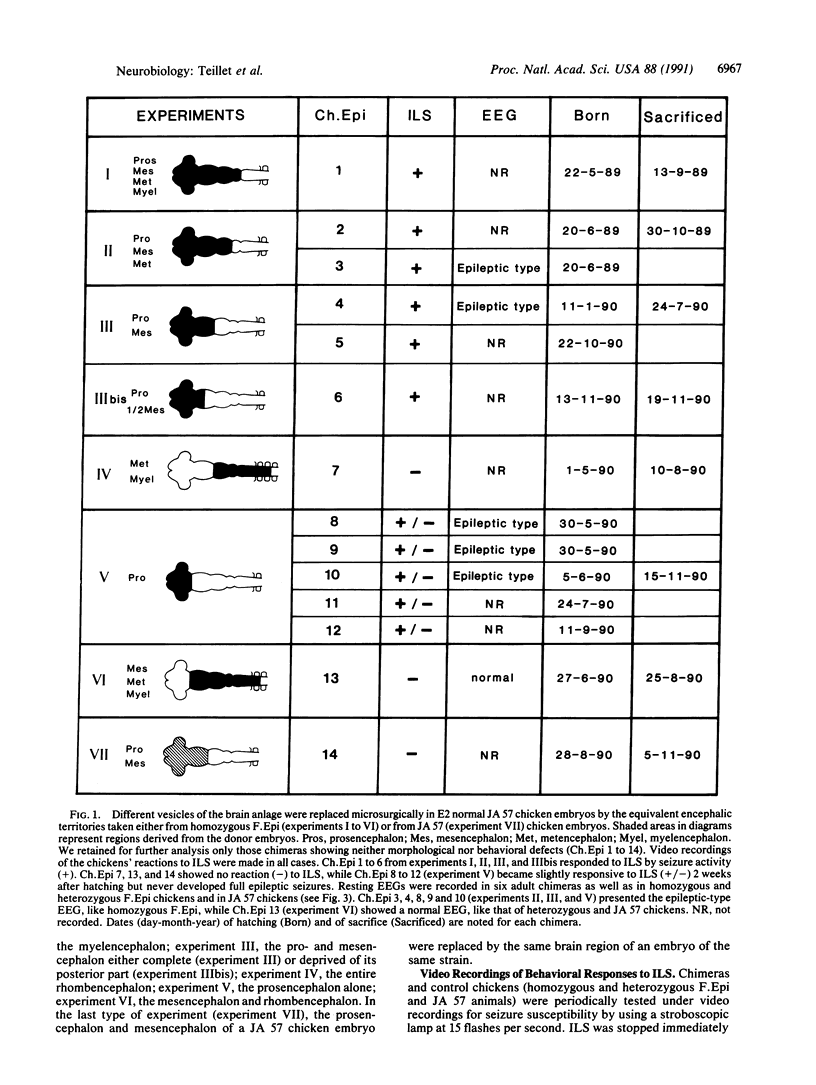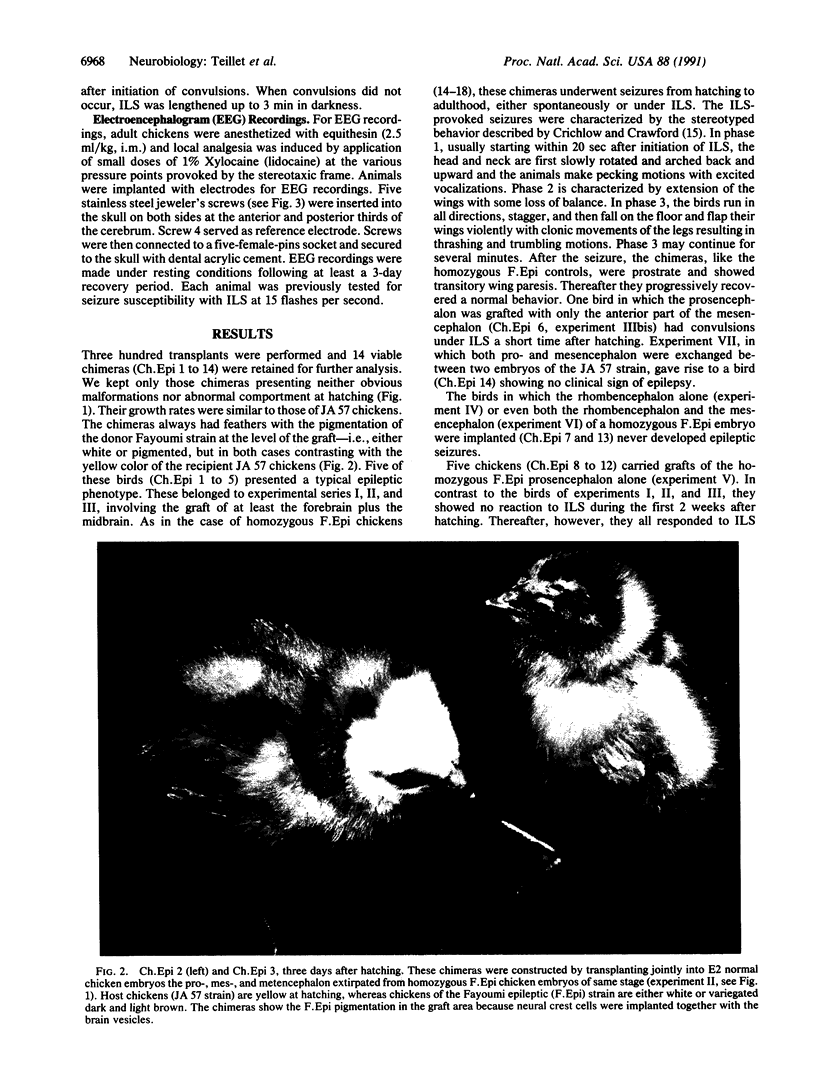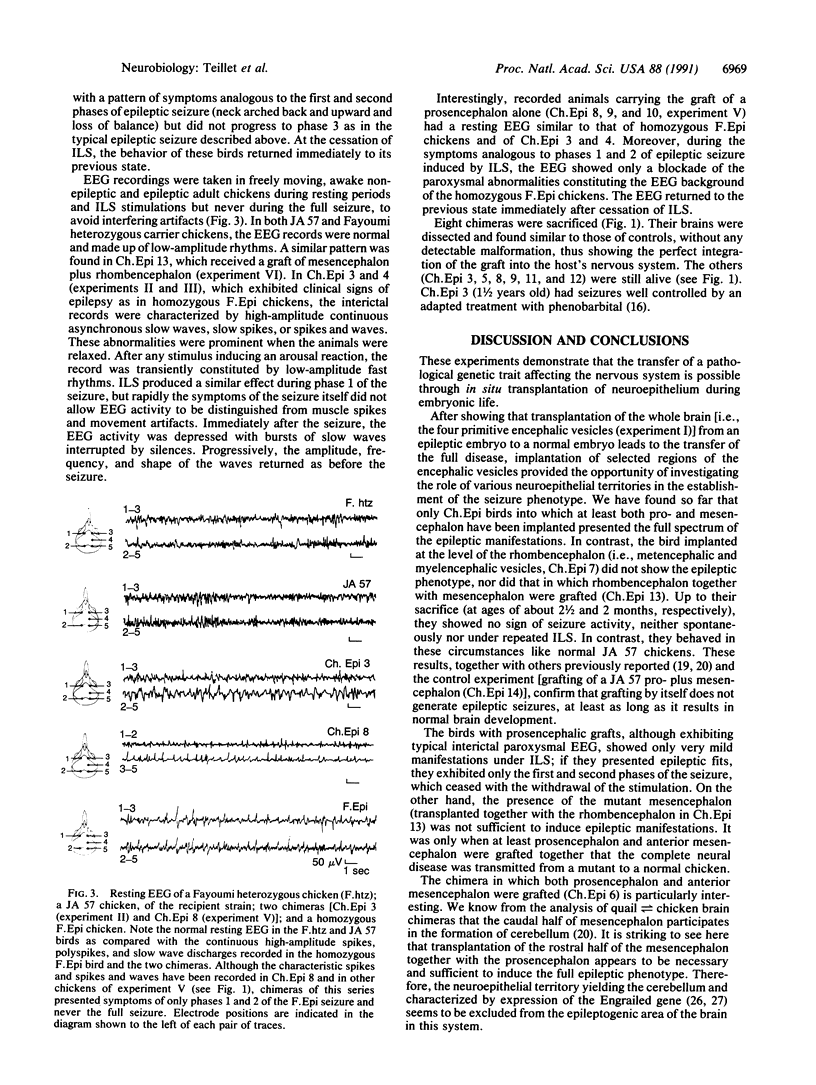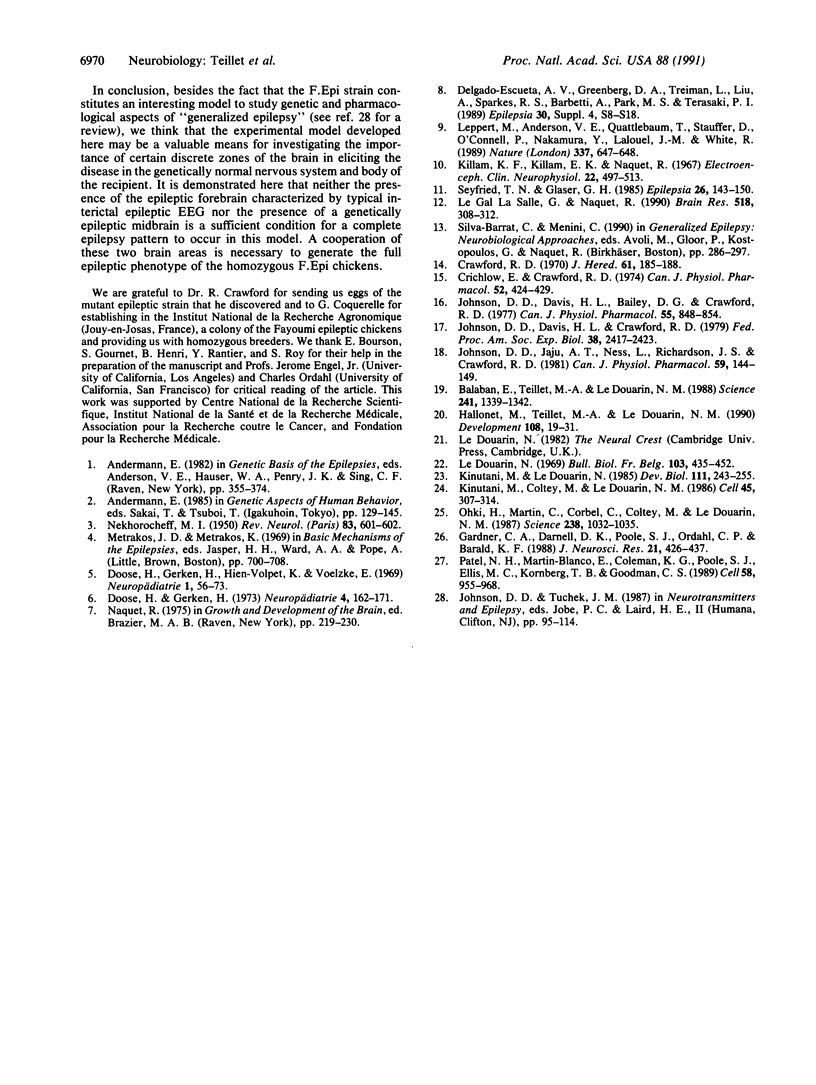Abstract
In the Fayoumi chicken, a spontaneous recessive autosomal mutation (F.Epi) is responsible for high susceptibility to seizures that are especially inducible by intermittent light stimulation. Substitution of defined areas of the encephalic neuroepithelium in normal chicken embryos at 2 days of incubation by their counterparts from homozygous F.Epi embryos generates the epileptic phenotype in the chimeras. It was found that grafting primordia of both prosencephalon and mesencephalon of homozygous F.Epi birds is necessary and sufficient for transfer of the full disease. When grafted alone, the homozygous F.Epi prosencephalon, although showing the typical epileptic interictal electroencephalogram, does not allow the complete epileptic seizures to occur in the hosts. Grafts of mesencephalon and/or rhombencephalon modify neither the behavior nor the electroencephalographic pattern of the recipient chickens. Cooperation of forebrain and midbrain activities is therefore required to yield epileptic seizures in this model.
Full text
PDF




Images in this article
Selected References
These references are in PubMed. This may not be the complete list of references from this article.
- Balaban E., Teillet M. A., Le Douarin N. Application of the quail-chick chimera system to the study of brain development and behavior. Science. 1988 Sep 9;241(4871):1339–1342. doi: 10.1126/science.3413496. [DOI] [PubMed] [Google Scholar]
- Crawford R. D. Epileptiform seizures in domestic fowl. J Hered. 1970 Sep-Oct;61(5):185–188. doi: 10.1093/oxfordjournals.jhered.a108078. [DOI] [PubMed] [Google Scholar]
- Crichlow E. C., Crawford R. D. Epileptiform seizures in domestic fowl. II. Intermittent light stimulation and the electroencephalogram. Can J Physiol Pharmacol. 1974 Jun;52(3):424–429. doi: 10.1139/y74-057. [DOI] [PubMed] [Google Scholar]
- Doose H., Gerken H., Hien-Völpel K. F., Völzke E. Genetics of photosensitive epilepsy. Neuropadiatrie. 1969 Jun-Jul;1(1):56–73. doi: 10.1055/s-0028-1091864. [DOI] [PubMed] [Google Scholar]
- Doose H., Gerken H. On the genetics of EEG-anomalies in childhood. IV. Photoconvulsive reaction. Neuropadiatrie. 1973 Apr;4(2):162–171. doi: 10.1055/s-0028-1091737. [DOI] [PubMed] [Google Scholar]
- Gardner C. A., Darnell D. K., Poole S. J., Ordahl C. P., Barald K. F. Expression of an engrailed-like gene during development of the early embryonic chick nervous system. J Neurosci Res. 1988 Oct-Dec;21(2-4):426–437. doi: 10.1002/jnr.490210234. [DOI] [PubMed] [Google Scholar]
- Hallonet M. E., Teillet M. A., Le Douarin N. M. A new approach to the development of the cerebellum provided by the quail-chick marker system. Development. 1990 Jan;108(1):19–31. doi: 10.1242/dev.108.1.19. [DOI] [PubMed] [Google Scholar]
- Johnson D. D., Davis H. L., Bailey D. G., Crawford R. D. Epileptiform seizures in domestic fowl. VI. Plasma phenobarbital concentrations and anticonvulsant activity. Can J Physiol Pharmacol. 1977 Aug;55(4):848–854. doi: 10.1139/y77-114. [DOI] [PubMed] [Google Scholar]
- Johnson D. D., Davis H. L., Crawford R. D. Pharmacological and biochemical studies in epileptic fowl. Fed Proc. 1979 Sep;38(10):2417–2423. [PubMed] [Google Scholar]
- Johnson D. D., Jaju A. T., Ness L., Richardson J. S., Crawford R. D. Brain norepinephrine, dopamine, and 5-hydroxytryptamine concentration abnormalities and their role in the high seizure susceptibility of epileptic chickens. Can J Physiol Pharmacol. 1981 Feb;59(2):144–149. doi: 10.1139/y81-024. [DOI] [PubMed] [Google Scholar]
- Killam K. F., Killam E. K., Naquet R. An animal model of light sensitive epilepsy. Electroencephalogr Clin Neurophysiol. 1967 Jun;22(6):497–513. doi: 10.1016/0013-4694(67)90058-2. [DOI] [PubMed] [Google Scholar]
- Kinutani M., Coltey M., Le Douarin N. M. Postnatal development of a demyelinating disease in avian spinal cord chimeras. Cell. 1986 Apr 25;45(2):307–314. doi: 10.1016/0092-8674(86)90395-8. [DOI] [PubMed] [Google Scholar]
- Kinutani M., Le Douarin N. M. Avian spinal cord chimeras. I. Hatching ability and posthatching survival in homo- and heterospecific chimeras. Dev Biol. 1985 Sep;111(1):243–255. doi: 10.1016/0012-1606(85)90449-x. [DOI] [PubMed] [Google Scholar]
- Le Douarin N. Particularites du noyau interphasique chez la caille Japonaise (Coturnix coturnix japonica) Bull Biol Fr Belg. 1969;103(3):435–452. [PubMed] [Google Scholar]
- Le Gal La Salle G., Naquet R. Audiogenic seizures evoked in DBA/2 mice induce c-fos oncogene expression into subcortical auditory nuclei. Brain Res. 1990 Jun 4;518(1-2):308–312. doi: 10.1016/0006-8993(90)90988-n. [DOI] [PubMed] [Google Scholar]
- Leppert M., Anderson V. E., Quattlebaum T., Stauffer D., O'Connell P., Nakamura Y., Lalouel J. M., White R. Benign familial neonatal convulsions linked to genetic markers on chromosome 20. Nature. 1989 Feb 16;337(6208):647–648. doi: 10.1038/337647a0. [DOI] [PubMed] [Google Scholar]
- NEKHOROCHEFF M. I. La stimulation lumineuse intermittente chez l'enfant normal. Rev Neurol (Paris) 1950 Dec;83(6):601–602. [PubMed] [Google Scholar]
- Ohki H., Martin C., Corbel C., Coltey M., Le Douarin N. M. Tolerance induced by thymic epithelial grafts in birds. Science. 1987 Aug 28;237(4818):1032–1035. doi: 10.1126/science.3616623. [DOI] [PubMed] [Google Scholar]
- Patel N. H., Martin-Blanco E., Coleman K. G., Poole S. J., Ellis M. C., Kornberg T. B., Goodman C. S. Expression of engrailed proteins in arthropods, annelids, and chordates. Cell. 1989 Sep 8;58(5):955–968. doi: 10.1016/0092-8674(89)90947-1. [DOI] [PubMed] [Google Scholar]
- Seyfried T. N., Glaser G. H. A review of mouse mutants as genetic models of epilepsy. Epilepsia. 1985 Mar-Apr;26(2):143–150. doi: 10.1111/j.1528-1157.1985.tb05398.x. [DOI] [PubMed] [Google Scholar]



